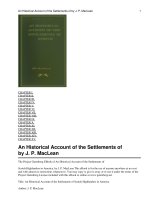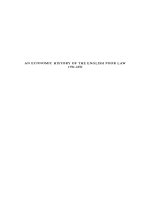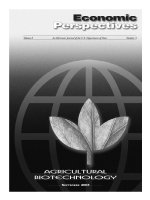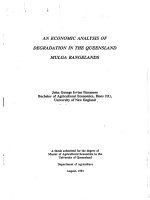the truth about human origins an investi gation of the creationevolution controversy as it relates to the origin of mankind
Bạn đang xem bản rút gọn của tài liệu. Xem và tải ngay bản đầy đủ của tài liệu tại đây (3.06 MB, 530 trang )
Library of Congress Cataloging-in-Publication
Brad Harrub (1970 - ) and Bert Thompson (1949 - )
The Truth About Human Origins
Includes bibliographic references, and subject and name indices.
ISBN 0-932859-58-5
1. Creation. 2. Science and religion. 3. Apologetics and Polemics
I. Title
213—dc21 2003111100
Apologetics Press, Inc.
230 Landmark Drive
Montgomery, Alabama 36117-2752
© Copyright 2003
ISBN: 0-932859-58-5
Printed in China
All rights reserved. No part of this book may be reproduced
in any form without permission from the publisher, except in
the case of brief quotations embodiedinarticlesorcritical re-
views.
DEDICATION
On occasion, there are certain individuals who quietly step
into our lives—and who leave such an indelible imprint that
we find our existence changed forever.
This book is dedicated to four such individuals, whom we
never will beable to repay fortheirunwavering moral and fi-
nancial support of our work, and who expect nothing in re-
turn for their incredible generosity—except our continued
pledge to teach and defend the Truth.
This book (and numerous others like it) never could have
come to fruition without the ongoing support of these two
Christian couples who, although separated by many miles,
walk side by side in their combined efforts to ensure the suc-
cess of Apologetics Press.
This side of heaven, few will know the full impact of their
sacrifices. Fortunately, God does.
TABLE OF CONTENTS
Dedication
Foreword . . . . . . . . . . . . . . . . . . . . . . . . . . . . . . . . vii
Introduction . . . . . . . . . . . . . . . . . . . . . . . . . . . . . . . 1
Chapter 1 — The “Record of the Rocks” [PartI] . . . . . . 3
BiologicalTaxonomyandHumanEvolution . . . . . . 4
DidManEvolve fromtheApes? . . . . . . . . . . . . . . . 10
AnExaminationofthe“Record of theRocks”. . . . . 12
Aegyptopithecus zeuxis . . . . . . . . . . . . . . . . . . 18
Dryopithecus africanus . . . . . . . . . . . . . . . . . . 18
Ramapithecus brevirostris . . . . . . . . . . . . . . . . 20
Orrorin tugenensis . . . . . . . . . . . . . . . . . . . . . 26
Australopithecus (Ardipithecus) ramidus . . . . . 27
Australopithecus anamensis. . . . . . . . . . . . . . . 28
Ardipithecus ramidus kadabba . . . . . . . . . . . . 29
Kenyanthropus platyops . . . . . . . . . . . . . . . . . 33
Chapter2—The“Record of the Rocks” [Part II] . . . . 41
Australopithecus afarensis . . . . . . . . . . . . . . . . 41
Lucy’s Rib Cage . . . . . . . . . . . . . . . . . 46
Lucy’s Pelvis and Gender. . . . . . . . . . 47
Lucy’s Appendages—Made for Bi-
pedalism, or Swinging from Trees?. . 50
Australopithecine Teeth:
More Evidence that
Lucy was Arboreal. . . . . . . . . . . . . . 53
Australopithecine Ears:
Human-like or Ape-like? . . . . . . . . . 54
Lucy: Hominid or Chimp? . . . . . . . . 55
Australopithecus africanus/
Australopithecus boisei . . . . . . . . . . . . . . . . . 57
The Laetoli Footprints . . . . . . . . . . . . . . . . 65
Homo habilis/Homo rudolfensis . . . . . . . . . . . 68
Homo erectus/Homo ergaster . . . . . . . . . . . . . . 75
Homo sapiens idaltu . . . . . . . . . . . . . . . . . . . 80
-i-
What Does the “Record of
theRocks”ReallyShow?. . . . . . . . . . . . . . . . . . . . 83
TheParadeofFossil Errors . . . . . . . . . . . . . . . . . . . 85
NeanderthalMan. . . . . . . . . . . . . . . . . . . . . . . . . . . 86
NebraskaMan . . . . . . . . . . . . . . . . . . . . . . . . . . . . . 88
PiltdownMan . . . . . . . . . . . . . . . . . . . . . . . . . . . . . 89
JavaMan . . . . . . . . . . . . . . . . . . . . . . . . . . . . . . . . . 90
RhodesianMan . . . . . . . . . . . . . . . . . . . . . . . . . . . . 91
Conclusion . . . . . . . . . . . . . . . . . . . . . . . . . . . . . . . 92
Chapter3—Molecular Evidence of Human Origins. . 99
ChromosomalCounts . . . . . . . . . . . . . . . . . . . . . . 103
RealGenomicdifferences . . . . . . . . . . . . . . . . . . . 105
“MitochondrialEve” . . . . . . . . . . . . . . . . . . . . . . . 111
TheDemiseofMitochondrialEve . . . . . . . . . . . . . 116
The Molecular Clock
—DatingMitochondrialAncestors . . . . . . . . . . . 121
Serious Errors in Mitochondrial
DNAData intheScientificLiterature. . . . . . . . . . . 126
Neanderthal vs. Human
DNA—
IsItaMatch? . . . . . . . . . . . . . . . . . . . . . . . . . . . . 128
Chapter 4 — The Problem of Gender
and Sexual Reproduction. . . . . . . . . . . . . . . . . . . . 135
“Intellectual Mischief and Confusion”—
OrIntelligentDesign? . . . . . . . . . . . . . . . . . . . . . 138
From Asexual to Sexual Reproduction—
TheOriginofSex. . . . . . . . . . . . . . . . . . . . . . . . . 142
The Lottery Principle . . . . . . . . . . . . . . . . 143
The Tangled Bank Hypothesis . . . . . . . . . 145
The Red Queen Hypothesis . . . . . . . . . . . 147
The
DNA Repair Hypothesis . . . . . . . . . . 148
Why Sex? . . . . . . . . . . . . . . . . . . . . . . . . . . . . . . . . 151
The50% Disadvantage . . . . . . . . . . . . . . . . . . . . . 159
MarsandVenus,orXandY? . . . . . . . . . . . . . . . . . 163
DifferencesAmongVariousSpecies . . . . . . . . . . . 164
-ii-
DifferencesinAnimalandHuman Sexuality . . . . 167
The Complexity of the Human
ReproductiveSystem. . . . . . . . . . . . . . . . . . . . . . 170
Anatomical Differences
BetweenHuman Males andFemales . . . . . . . . . . 173
Cellular Differences Between
HumanMalesandFemales . . . . . . . . . . . . . . . . . 175
TheFutureofHumanReproduction . . . . . . . . . . . 178
Chapter5—TheProblem of Language . . . . . . . . . . 183
Evolutionary Theories
ontheOriginofSpeech . . . . . . . . . . . . . . . . . . . . 184
Adam—The First Human
toTalkandCommunicate . . . . . . . . . . . . . . . . . . 186
Tower of Babel—and
TheUniversalLanguage . . . . . . . . . . . . . . . . . . . 188
The Brain’s Language
Centers—CreatedbyGod . . . . . . . . . . . . . . . . . . 189
AnatomyofSpeech . . . . . . . . . . . . . . . . . . . . . . . . 192
BirdsofaFeather—OrNakedApe? . . . . . . . . . . . . 194
ComplexityofLanguage—Uniquely Human . . . . 202
Conclusion . . . . . . . . . . . . . . . . . . . . . . . . . . . . . . 205
Chapter6—TheProblem of the Brain . . . . . . . . . . . 209
Introduction . . . . . . . . . . . . . . . . . . . . . . . . . . . . . 209
HistoryoftheBrain . . . . . . . . . . . . . . . . . . . . . . . . 212
TheEvolutionofthe Brain . . . . . . . . . . . . . . . . . . . 215
GrowingNeurons . . . . . . . . . . . . . . . . . . . . . . . . . 237
TheBrainVersusaComputer . . . . . . . . . . . . . . . . 241
TwelveCranialNerves. . . . . . . . . . . . . . . . . . . . . . 242
Conclusion . . . . . . . . . . . . . . . . . . . . . . . . . . . . . . 244
Chapter 7 — The Evolution
of Consciousness [Part I] . . . . . . . . . . . . . . . . . . . . . 247
TheOriginofLife . . . . . . . . . . . . . . . . . . . . . . . . . 248
TheOriginoftheGeneticCode. . . . . . . . . . . . . . . 251
TheOriginofSex. . . . . . . . . . . . . . . . . . . . . . . . . . 252
- iii -
TheOriginofLanguageand Speech . . . . . . . . . . . 253
The Origin of Consciousness—
“TheGreatestofMiracles” . . . . . . . . . . . . . . . . . 253
Importance of Human Consciousness. . . 253
“Mystery” of Human Consciousness . . . . 256
Consciousness in General . . . . . . . . 257
Consciousness and the Brain . . . . . . 259
Consciousness and the Mind . . . . . . 260
ConsciousnessDefined . . . . . . . . . . . . . . . . . . . . . 262
Why—andHow—DidConsciousnessArise? . . . . . 271
Why Did Consciousness Arise? . . . . . . . . 272
Why Do We Need Consciousness? . . . . . 276
How Did Consciousness Arise? . . . . . . . . 286
Evolutionary Bias and the
Originof HumanConsciousness . . . . . . . . . . . . 296
What Does All of This have to do with
theOriginof Human Consciousness? . . . . . . . . 301
RadicalMaterialism—A“Fishy”Theory. . . . . . . . . . 306
DoAnimals PossessConsciousness? . . . . . . . . . . . 313
The Brain, the Mind, and
HumanConsciousness . . . . . . . . . . . . . . . . . . . . 328
Materialism, Supernaturalism,
andtheBrain/MindConnection . . . . . . . . . . . . 330
TheConceptofMind. . . . . . . . . . . . . . . . . . . . . . . 333
Chapter8—TheEvolution
of Consciousness [Part II] . . . . . . . . . . . . . . . . . . . . 347
Theories of the Origin
ofHumanConsciousness . . . . . . . . . . . . . . . . . . 347
The“HardProblem”of Human Consciousness. . 350
“Failure is not an Option” . . . . . . . . . . . . 352
TheoriesofHumanConsciousness. . . . . . . . . . . . 353
Dualism. . . . . . . . . . . . . . . . . . . . . . . . . . . 354
Monism . . . . . . . . . . . . . . . . . . . . . . . . . . . 361
Psychical Monism. . . . . . . . . . . . . . . . . . . 363
-iv-
Radical Materialism (Functionalism) . . . . 364
Panpsychism . . . . . . . . . . . . . . . . . . . . . . . 373
Epiphenomenalism . . . . . . . . . . . . . . . . . . 375
Identity Theory. . . . . . . . . . . . . . . . . . . . . 382
Nonreductive Materialism/
Emergent Materialism . . . . . . . . . . . . . . 387
Dualist-Interactionism . . . . . . . . . . . . . . . 393
Conclusion. . . . . . . . . . . . . . . . . . . . . . . . . . . . . . . 419
Chapter 9 — The Problem
of Skin Color and BloodTypes . . . . . . . . . . . . . . . . 429
Whatisa“Race”?. . . . . . . . . . . . . . . . . . . . . . . . . . 435
WhySoManyRacialCharacteristics? . . . . . . . . . 439
TheOriginof Man’s “Colors”. . . . . . . . . . . . . . . . 443
OtherFactors. . . . . . . . . . . . . . . . . . . . . . . . . . . . . 448
Differences Between Human
andAnimalBloodTypes . . . . . . . . . . . . . . . . . . . 453
Componentsof Human Blood . . . . . . . . . . . . . . . 454
DifferentBloodTypes . . . . . . . . . . . . . . . . . . . . . . 457
TheAdamandEveIssue . . . . . . . . . . . . . . . . . . . . 458
Humans,Animals,andBlood . . . . . . . . . . . . . . . . 459
WhataboutBloodTypesof OtherAnimals?. . . . . 459
WhataboutHibernation? . . . . . . . . . . . . . . . . . . . 460
WhataboutBirds? . . . . . . . . . . . . . . . . . . . . . . . . . 461
WhataboutFish? . . . . . . . . . . . . . . . . . . . . . . . . . . 461
Conclusion. . . . . . . . . . . . . . . . . . . . . . . . . . . . . . . 461
Chapter 10 — Conclusion . . . . . . . . . . . . . . . . . . . . 463
References. . . . . . . . . . . . . . . . . . . . . . . . . . . . . . . 467
Subject Index . . . . . . . . . . . . . . . . . . . . . . . . . . . . . 507
Name Index . . . . . . . . . . . . . . . . . . . . . . . . . . . . . . 513
-v-
- vii -
Eversince Copernicusdecidedto put the Sun atthecenter
of the solar system, various scientists and philosophers have
worked overtime in their efforts to diminish the role of human
-
kind in the Universe. As a result, we have gone from beingthe
crowning glory of God’s creation, to a hairless ape stuck on a
smallplanetcirclingamediocresunin the distantreaches of
one arm of a single galaxy thatis one among billions ofothers.
Someofthe most widely readauthorsin the evolutionary camp
(such as Carl Sagan, Stephen Jay Gould, Steven Weinberg, and
RichardDawkins)have repeatedly emphasizedthelackofour
uniqueness, and the “luck” supposedly related to our very ex-
istence (mundane as it may be).
Thus, man is viewed as occupying neither the center of the
Universe,noranysortofpreeminentplaceinthelivingworld;
rather, we arenothing more, norless, than theproduct of the
same natural, evolutionary processes that created all of the
“other animals” around us. In short, we are at best a “cosmo-
logical accident.” Or, to express the idea in the words of the
late, eminent evolutionist of Harvard, George Gaylord Simp
-
son: “Man is theresult of a purposeless and natural processthat
didnothavehiminmind.Hewasnotplanned.Heisastateof
matter, a formoflife, a sort ofanimal,and a species ofthe Or
-
der Primates, akin nearlyor remotely to all of life andindeed
to all that is material” (1967, p. 345).
According to the most extreme version of this view, it is the
utmostarroganceonman’sparttoidentifyanycharacteristic
that distinguishes him from members of the animal kingdom.
Any differences we mightthink we perceive aremerelya mat
-
ter of degree, and for all the things we may do better, there are
other things we certainly doworse.Otherprimates, in partic
-
ular, are worthy of coequality because they are supposed to
- viii -
be our nearestliving relatives. Someeven have goneso far as
to suggest that this kinship puts a burden on us to make laws
grantingspecialrightstoapes(CavalieriandSinger,1993; cf.
Maddox, 1993).
The problem with such extreme positions is that they pro
-
vide no reasonable stopping point. Ifweincludeotherprimates
in a “global community of equals,” then why not include all
mammals, all animals, all living things? If apes’ rights advo
-
cates can devise criteria thatdivide humans and apes fromthe
other animals, then is it not equally legitimate for humans to
devise criteria that separate us from the apes? In other words,
can we say that there are no essential differencesbetweenhu
-
mans and, say, chimpanzees?Toputitanotherway,arethere
enough similarities to make us treat all primates on the same
level (or almost on the same level) as members of our own
species? Or is man truly unique in his own right?
In this book, we affirm the unqualified uniqueness of hu-
mankind.Thefactis,therearenumerousdifferent aspects that
man possesses—which animals do not. And each of those as-
pects not only is significant, but also serves to separate man
from the animalkingdom in a most impressive fashion. Con-
sider, for example, the following few examples amongmany
that could be offered (and will be, later in this volume).
•
First, man is capable of speaking and communicat
-
ing his thoughts via language.
•
Second, man can improve his education, accumu
-
late knowledge, and build on pastachievements.
•
Third, man is creative,andcanexpresshimselfviaart,
music, writing, etc.
•
Fourth, closely related to man’s creative ability is his
gift of reasoning.
•
Fifth, included in man’s uniquenessishisfree-will ca
-
pacity to make rational choices.
•
Sixth, only man lives by a standard of morality, and
has the ability to choosebetween right and wrong.
-ix-
•
Seventh, only man possesses a conscience.
•
Eighth,onlymancanexperience heart-feltemotions.
•
Ninth, man alone possesses a unique, inherent reli
-
gious inclination; i.e., hehastheabilityto worship.
•
Finally, and very likely most important, is the fact that
man bears thespiritual imprint of God due to thefact
that he possesses an immortal soul.
Knowing “the truth about human origins” centers on these
(and other related) factors. It is our goal in thisbook to exam
-
ine a number of these issues, and to provide what renowned
American news commentator Paul Harvey might call “the rest
of the story.” We inviteyou to joinus on afascinating journey
examiningtheoriginanduniquenessofhumanity—a journey
that, we promise, will be anything but dull, and one that may
even changethe way you thinkaboutyourself and your fellow
travelers in this pilgrimage we call “life.”
Brad Harrub
Bert Thompson
December 2003
It begins very early in a child’s life, andnever recedes—the
constant barrageof speculation suggesting that men evolved
from ape-likecreaturesovermillionsofyearsofgeologictime.
By early adolescence, many children already have a subcon
-
scious image of early man as a club-carrying, long-armed, hair-
covered creaturewho lived in a cave. High school sciencebooks
reinforce this notion with pictures of creatures like Lucy and
Neanderthal Man, and by the end of their college careers, stu
-
dents frequently have accepted this evolutionary progression
of man as a scientific fact. As such, man’s existence, and his
statusintheUniverse,are placedonaleveljust slightly above
that of the animals.
Many in the current generation view man as little more than
aneducatedapethatistheendresultoffortuitous(andcom-
pletely natural) circumstances. All of our actions and behav-
iors thusare viewed simply as “carry-overs” from our ape-like
ancestry. With fragmentary skulls of our alleged ancestors in
hand, evolutionists strive diligently to remove any vestige of
a supernatural Creator.
But what isthereal truth about humanorigins? What do
those fossilized skulls really tell us about early man and his
appearance on the Earth? This book begins by examining the
“record of the rocks” in exacting detail, and in so doing, re
-
veals the paucity of evidence for evolutionary theory. It docu
-
ments that on more than one occasion, evolutionary scientists
have paraded a “missing link” before the world, only to dis
-
cover that it was notevencloseto being human (and, insome
cases, actually was fraudulent!).
This volumealsoaddresses
DNAsimilarities,aswell as the
frequently parroted claim that chimpanzees are “98% human.”
While such announcements make for good headlines, the sci
-
entific data portend something entirely different.
-1-
In uncovering the truth about human origins, we also ex
-
amine three critically important problems that evolutionists
have struggled mightily to explain—or, at times, have simply
avoided altogether: (1)the origin of language and communi
-
cation; (2) the origin of gender and sexual reproduction; and
(3) the origin of consciousness. These physiological differences
represent vast chasms between humans and animals—chasms
that evolutionists have not been able to span with either the
available scientific evidenceorfancifulhypotheticalconstructs.
We invite you to examine the data presented here—and then
decide foryourselfthe truth about human origins. Person
-
ally, we believe that there is a far better explanation for the
origin of mankind than organic evolution—to wit, a divine Cre-
ator. By the time you have finished reading this book, see if you
don’t agree.
-2-
1
Homo sapiens, the genus and species classification for hu
-
mans, means literally “wise man”—a designation that at times
appears almost comical in light of the contentious claims of
evolutionists thathumans descendedfrom ape-like ancestors.
The pictures of ourputative predecessors adorn thewallsof
science classrooms all over the world. Most of us, in fact, are
familiar withthe charts that show an ape on one end, a human
at the other, and a whole host ofape-like intermediates inbe-
tween. In aneffort to bolster theirtheory of common descent
for all living creatures,evolutionistshaveworked feverishly to
demonstrate a convincing continuity betweenhumans and our
alleged ape-like ancestors. And, admittedly, at times they ap-
pear to have done their job so wellthattheape-likeinterme
-
diatestheydepictattainsuchfamethatchildrenimmediately
recognizetheirnamesandcaneasilyrecitetheir traits. Forin
-
stance, whilemany individuals maynot recognize the scientific
name of Australopithecus afarensis, theyvery likely have heard
of “Lucy” (the popularname fora famous set of fossils). Pic
-
tures of her fossilized remains have been paraded before us as
an example ofwhat is arguably themost famous, and themost
widely known, of all the so-called “missing links.”
Using a handful of bone fragments, a piece of a skull, or a
few teeth, evolutionary artists portray what they want us to
believe these hairy, ape-likecreaturesmusthave looked like.
Frequently,wesee them carrying primitive clubs,livingin
-3-
caves, or huddled around a firewithothersoftheir kind. And
so, from a very young age, children deposit deep within the
recesses of their minds theimagesofthesecreaturescrawling
down out ofthe trees inAfrica, learning to walkuprightly, and
eventually evolving larger brains, advanced intelligence, and
language. This image, however, is completely fictitious—as
we will document in this chapter, and as some evolutionists
themselves have been willing to admit publicly. Paleontologist
DouglasPalmer,forexample,stated in the March16, 2002 is
-
sue of New Scientist: “The trouble is we probably know more
about the evolution ofextinct trilobites than we do about hu
-
man evolution” (173[2334]:50).
In this book,we would like tocritically examine theactual
evidence of human origins found within the fossil record. Ad-
ditionally, we would like to offer an updated, “corrected” in-
terpretation of that evidence, because the current evolution-
based interpretation simply does not fit the available facts.
BIOLOGICAL TAXONOMY
AND HUMAN EVOLUTION
As we begin to assemble, disassemble, and then reassem-
ble the puzzleof the “record ofthe rocks” in regard tohuman
evolution, we first need to understand the terminology cur
-
rently in use in evolutionary circles regardingwhat frequently
is called“fossilman.”Abriefrefreshercourseinbiological
nomenclature seems appropriate at this juncture.
Scientists employ what is commonly referred to as the bi
-
nomial nomenclature system, first devised by the Swedish
botanist Carolus Linnaeus (1707-1778), and revised somewhat
down through the years. Biologists today group all living or
-
ganisms into specific hierarchical assemblages, in which each
category is “nested” within thenexthighercategory. Depicted
in a graphicformat, the assemblages wouldappear something
similartothechartasseen on thenextpage(afterMayr, 2001,
p. 23).
The Truth About Human Origins
-4-
The earliest scientist to attempt to divide organisms into
recognizable groups (whichhecalled “kingdoms”) was Lin-
naeus. Herecognized only two distinct groups: Animalia(ani-
mals) and Plantae (plants). Later modifications to the two-
kingdom concept weremade by the German embryologist,
Ernst Haeckel (1834-1919), who suggested the addition of a
third kingdom (which he referred to astheProtista) that in
-
cluded twogroups:(1)Protozoans (like, for example,theamoe
-
ba); and (2) Monera.
Later, American biologist Herbert F. Copeland (1902-1968)
ofSacramentoCityCollegeinSacramento,California,split
Haeckel’sMoneraintotwo groups. Heretainedtheoriginal
Moneradesignation,but used it to referonlyto prokaryotes
(i.e., bacteria in the traditional sense). He placed the eukary
-
otes (plus various algae) into a new kingdom, the Protoctista.
[Eukaryotes are cells that are characterizedbymembrane-
bound organelles (such as the nucleus,ribosomes, et al.). An
-
imals, plants, fungi, and protoctists are eukaryotes. Prokary
-
-5-
otes arecells that possessa plasma membranethemselves, yet
lack a true nucleus and membrane-bound organelles within
their cytoplasm. In prokaryotes, the
DNA normally is found
in a single, naked, circular chromosome (known as a geno
-
phore) that lies free in the cytoplasm. Archaebacteriaandeu
-
bacteria are prokaryotes.]
Then, in 1959, American Robert H. Whittaker of Cornell
University proposed his now-famous “five-kingdom concept,”
which included Animalia, Plantae, Fungi, Protoctista, and
Monera(see Whittaker, 1959). Ofthe five kingdoms, one
(Monera) is prokaryotic, and four (Animalia, Plantae, Fungi,
and Protoctista) are eukaryotic. It is the five-kingdom con
-
cept that still is used widely by most scientists and that was,in
fact,thebasisfortheclassic1998 atlas of thelivingworld,Five
Kingdoms: An Illustrated Guide to the Phyla of Life on Earth,by
Lynn Margulis and Karleve V. Schwartz that has become prac-
tically the taxonomists’ “Bible.”
However,asmolecular biology began tocomeintoits own,
and as scientists were able to examine the
DNA of various or-
ganisms, it became apparent to them that the five-kingdom
concept no longer providedenough accuracy. Carl Woese, a
biologist from the University of Illinois, proposed two radi-
cal changes in the taxonomic system then in place. First, he
divided the bacteria (Whittaker’s Monera) into two distinct
groups that, at the time, he labeled: (1) Archaebacteria and;
(2) Eubacteria. [Archaebacteria (from the Greekarchae, mean
-
ing ancient)are organisms that exist in a variety of “hostile”
environments such as hot-water springs, oreven within solid
rock,frequentlyarethermophilic(heat-loving),produceme
-
thane,andareanaerobic(liveonlyintheabsence of free oxy
-
gen). ForanexcellentdiscussionoftheArchaea,seeWard and
Brownlee,2000, pp.6-10.]Second,Woeseproposedanen
-
tirely new category, the “domain,” which he boldly placed
above kingdoms. In his scheme, the five kingdoms were spread
overthreedomains:(1)Archaea(whichWoesesubdivided
into two kingdoms—Crenarchaeota(heat-lovingforms)and
The Truth About Human Origins
-6-
Euryarchaeota (mainly methane-producing forms); (2) Bac
-
teria;and(3)Eucarya(whichincludestheplants,animals, pro
-
tests, and fungi). [For an up-to-date treatment ofthehistoryof
the taxonomicmatters discussed here, see Tudge, 2000, pp.
95-106.]
Today, the current status in taxonomy acknowledges Woese’s
“domain”proposal.However,thefive-kingdomconcept still
remains extremely popular, and likely will until such a time
at some point in thedistant future when it isovertaken by the
domain concept. [Identification of an organism usually is
given by listing only the genus and species. For example, the
common pine tree is known as Pinus ponderosus. The common
rat is Rattus rattus. The common housecat is referred to as Felis
domesticus. And so throughout this book whenever you see two
Latinized names being used (e.g.: Australopithecus africanus or
Homo erectus), that simply represents the genus and species of
the particular creature under discussion.]
At this point, we would like to call attention to three spe-
cific terms that are used when man or man’s alleged ancestors
are beingdiscussedsincetheycurrentlyare the source ofsome
controversy within the taxonomic branch of science.These
terms are: (1) hominoid; (2) hominid; and(3) hominin. An ex-
planation is in order.
Briefly stated, under the broad outlines of the Linnaeansys
-
tem,humanswouldbeclassifiedasfollows:Animalia(since
man is consideredas an animal); Chordata(because humans
have backbones); Mammalia (since humanshavehair and
suckle their young);Primates (because humans share certain
morphological traits with apes, monkeys, and lemurs); Ho
-
minidae (since humans are separated from “other apes” by,
among other traits, bipedalism); Homo(mankind’s generic
classification ashuman); and sapiens (the species name desig
-
nating “wise”). In chart form, then, man’s exact scientific clas
-
sification would be rendered asatappearsinthe listing on the
next page.
-7-
Kingdom Animalia
Phylum Chordata
Subphylum Vertebrata
Superclass Tetrapoda
Class Mammalia
Order Primates
Suborder Anthropoidea
Tribe Catarrhina
Superfamily Hominoidea
Family Hominidae
Subfamily Homininae
Tribe Hominini
Genus Homo
Species sapiens
Subspecies sapiens
As the chart above indicates, the Linnaean system also rec-
ognizes groupings such as superfamilies, subfamilies, tribes,
etc. In the case of humans, the most frequently recognized
superfamily is the Hominoidea (from which the term “homi-
noids” is derived). The term hominoid includes all of the liv-
ingapes.Infact,under thesuperfamilyHominoidea,three
families are included: (1) the Hylobatidae (which includes the
so-called lesser apes of Asia, the gibbons, and the siamangs);
(2) theHominidae (which includes living humans and fossil
apesthatallegedlypossessasuite of characteristicssuchasbi
-
pedalism, reduced canine toothsize,increasing brain size, etc.);
and (3) the Pongidae (which includes the remaining African great
apes such as gorillas, chimpanzees, and the Asian orangutan).
It is from the level ofthe superfamily onwardthat most ofthe
present debate over the classification of humans begins. In a
December 4, 2001 article titled “Is It Time to Revise the Sys
-
tem of Scientific Naming?” on National Geographic’s Web site,
Lee R. Berger, a paleoanthropologist at the University of Wit
-
watersrand in Johannesburg, South Africa, discussed the con
-
troversy from anevolutionaryviewpoint (whichexplains the
evolution-based dates, which we do not accept).
The Truth About Human Origins
-8-
Modern-day genetic research is providing evidence
that morphological distinctions are not necessarily
proof of evolutionary relatedness. Recent evidence
suggests that humansare in fact more closely related
to the chimpanzee and bonobo than either species is
to the gorilla. Chimps and humans share something
like 98 percent of genes, indicating that we share a
common ape ancestor.
Divergence timesbetweenthetwogroupsbasedon
a molecular clock suggestthatthechimpanzee/human
split occurred between five and seven million years
ago. In turn, the African apes, including humans, are
more closelyrelatedtoeach otherthananyaretothe
orangutan.
In recognition ofthese and other genetic relationships,
some argue that we must overhaul the present mor-
phologically based classification system for one that
ismorerepresentative ofourtrue evolutionaryrela-
tionships as evinced by our genes.
This is where the term hominin comes intoplay. Un-
der the new classification model, hominoids would
remain a primate superfamily, as has always been the
case.Underthishominoid umbrella wouldfallorang-
utans, gorillas, chimps, and humans, all inthe family
Hominidae.
Inrecognitionoftheirgenetic divergence some 11to
13 million years ago, the orangutans would be placed
in thesub-familyPonginaeandtheAfricanapes, in
-
cludinghumans,wouldall belumpedtogetherin the
sub-family Homininae. The bipedalapes—all of the
fossil species as well as living humans—would fall into
the tribe Hominini (thus hominin). All of the fossil gen
-
era, such as Australopithecus, Ardipithecus, Kenyanthropus,
and Homo, would fall into this tribe.
A few evolutionary biologists wanta more extreme
classification, which would include humans and chim
-
panzees within the same genus, the genus Homo (2001,
emp. added).
-9-
The taxonomic controversy, therefore, turns out to be a
matter of “old” versus“new.” Under the old, morphologically
based system, the term “hominid” refers to the bipedal ape
lineage (whichwouldincludehumans).Underthenew,mo
-
lecular-based system,hominidrefersnotjusttobipedalapes,
but rather to the broader grouping of all the great apes. Thus,
under the newsystem, “hominin” (asopposed to “hominid”)
would refer toall(livingordead)speciesofbipedalapes(which,
again, would include humans). It is likely thatthenewerterm
will “winout” in the end (as Berger noted in his article). Until
it does, however, we may expect tocontinue to see both terms
appear in the scientific literature concerning human classifi
-
cation and/or evolution.
There is one part of the evolutionary classification scheme,
however, wherethereisnocontroversy. Every man, woman,
andchildlivingtodayisclassified asHomosapienssapiens.
DID MAN EVOLVE FROM THE APES?
Evolutionists today, of course, do not contend that man de-
scended from the apes. Instead, they contend that both men
andapesdescendedfromacommon ancestor. We, however,
agree with the lateevolutionarypaleontologistof Harvard
University, GeorgeGaylordSimpson, who summed up such
an idea quite succinctly when he wrote:
On this subject, by the way, there has been way too
much pussyfooting. Apologists emphasize that man
cannot bedescendantofanyliving ape—a statement
that is obvious to the verge of imbecility—and go on
tostateor implythatmanisnotreallydescended from
an ape or monkey at all, but from an earlier common
ancestor. In fact, that earlier ancestor would certainly
be calledanapeormonkeyinpopular speech byany
-
onewho sawit.Sincethe termsapeandmonkey are
defined by popular usage, man’s ancestors were apes
or monkeys (or successively both). It is pusillanimous
[cowardly—
BH/BT] if not dishonest for an informed
investigatortosayotherwise(1964, p.12,emp.in orig).
The Truth About Human Origins
-10-
Ironically, some evolutionists have even gone so far as to
suggest—albeit incorrectly—that Charles Darwin himself never
claimed that man came from the apes. Yet he most certainly
did. In The Descent of Man, Darwin wrote:
But a naturalist would undoubtedly have ranked as
an ape or a monkey, an ancient form which possesses
many characterscommonto the Catarhine and Plat
-
yrhinemonkeys,othercharactersinanintermediate
condition, and some few, perhaps, distinct from those
now found in either group. And as man from a ge
-
nealogical point of view belongs to the Catarhine
or Old World stock, we must conclude, however,
much the conclusion may revolt our pride, that
our early progenitors would have been properly
designated. But we must not fall into the error of sup-
posingthattheearly progenitors ofthewholeSimian
stock,including man, was identical with, or evenclosely
resembled, any existingape or monkey (1871, pp.
519-520, emp. added).
Since the time of Darwin, evolutionists have struggled to
devise plausible theories about whythose ancient apes de-
cided to leave the confines of the treetops in favor of bipedal
locomotionontheplains.Marcel-PaulSchutzenbergerde-
fined the problem well when he lamented:
Gradualists [those who believe in slower rates of evo
-
lution—
BH/BT] and saltationists [those who believe
in a more rapid rate of evolution—
BH/BT] alike are
completely incapable of giving a convincing expla
-
nation ofthe quasi-simultaneous emergence of anum
-
ber of biological systems that distinguish human be
-
ings from the higher primates: bipedalism, with the
concomitantmodificationofthepelvis, and, without
adoubt,thecerebellum,a muchmoredexteroushand,
with fingerprints conferring an especially fine tactile
sense; the modifications of the pharynx which per
-
mits phonation; the modification of the central ner
-
vous system, notably at the level of the temporal lobes,
permitting the specific recognition of speech. From
the point of view of embryogenesis, these anatomi
-
-11-
cal systems are completely different fromone another.
Eachmodificationconstitutesagift,a bequest from a
primatefamilytoits descendants. Itisastonishingthat
these gifts should have developed simultaneously
(1996, pp. 10-15).
Itisindeed“astonishing”thattheseapes(or,to be more polit
-
ically correct, “ape-like creatures”) could have experienced
the “simultaneous emergence of a number of biological sys
-
tems” that distinguish them from human beings. It is equally
“astonishing” to see how evolutionists have interpreted the
evidence of the fossil record that they insist establishes such
an event asactuallyhaving occurred. Weinvite you to joinus
on this fascinating journey while we investigate “the record
of the rocks” as it applies to human evolution.
AN EXAMINATION OF THE
“RECORD OF THE ROCKS”
As we begin an examination of the fossil record as it alleg-
edly relatestohumanevolution,let’sbebluntaboutonething.
Of all the branches to be found on that infamous “evolution-
ary tree of life,” theone leading to manshould be the bestdoc-
umented. Afterall, as the most recent evolutionary arrival,
pre-human fossils supposedly would have been exposed to
natural decay processes for the shortest length of time, and
thus should be better preserved and easier to find than any
others. [Consider, for example, how many dinosaur fossils we
possess, and those animals were supposed to have existed
over sixty-five millionyears before man!]In addition, since
hominid fossils are of the greatest interest to man (because they
are supposed to represent his past), it is safe to say that more
peoplehavebeensearchingforthemlonger than foranyother
type of fossils. If there are any real transitional forms any
-
where in the world, they should be documented most abun
-
dantly inthelineleadingfrom the first primate to modernman.
Certainly, the fossils in this field have received more public
-
ity than in any other. But exactly what does the human fossil
record reveal?
The Truth About Human Origins
-12-









